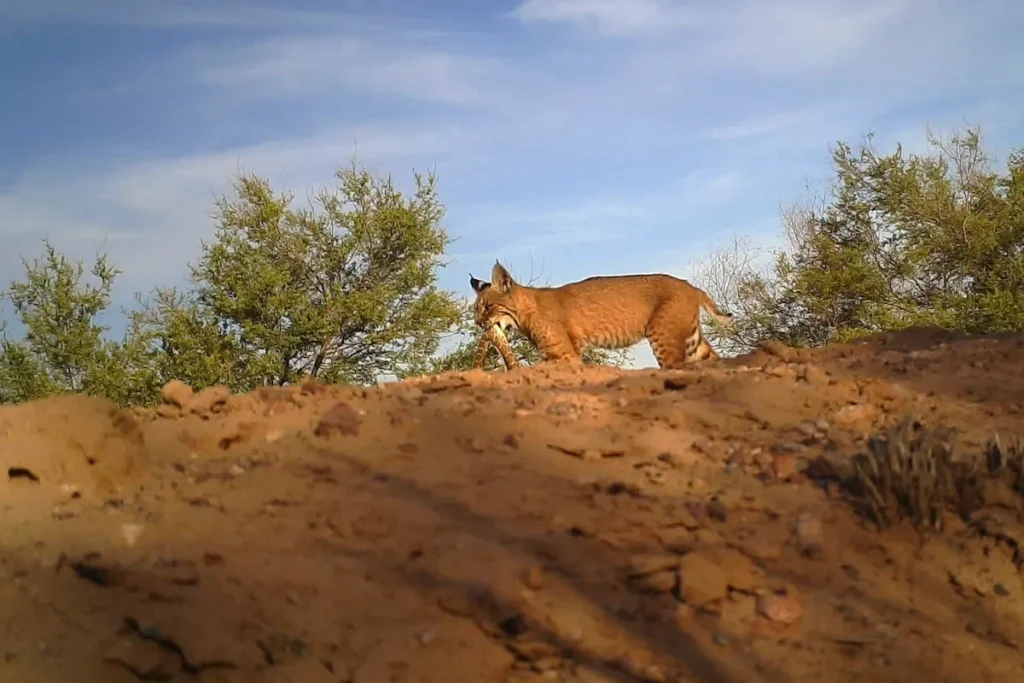A trail camera in Arizona’s Imperial National Wildlife Refuge captured a remarkable image of a bobcat carrying a rattlesnake in its mouth, showcasing the cat’s adaptability and bravery. This unusual prey is an exception to the bobcat’s typical diet of rabbits, rodents, and birds. Rattlesnakes are occasionally eaten by bobcats as a way to vary their diet. The Imperial National Wildlife Refuge is home to a variety of wildlife, including bobcats and rattlesnakes. This remarkable sighting highlights the bobcat’s ability to thrive in its environment, taking advantage of available prey, and there’s more to uncover about these fearless hunters.
Unusual Prey for a Bobcat
In a rare and intriguing sighting, a bobcat was captured on a trail camera carrying a rattlesnake in its mouth, a demonstration to the adaptability and fearlessness of these predators.
This unusual prey item is not typically part of a bobcat’s diet, which usually consists of rabbits, rodents, lizards, birds, and snakes.
However, rattlesnakes are an exception, and bobcats are one of the few native predators willing to eat them.
The Imperial National Wildlife Refuge in Arizona, where the photo was taken, is home to a variety of wildlife, including bobcats and rattlesnakes.
The U.S. Fish and Wildlife Service posted the photo, sparking interest due to the venomous nature of the rattlesnake.
This remarkable sighting highlights the bobcat’s ability to thrive in its environment, taking advantage of available prey, even if it means tackling a venomous snake.
This adaptability is a demonstration of the bobcat’s remarkable hunting prowess and fearless nature.
Hunting Habits and Diet
As skilled hunters, bobcats have evolved to thrive in their environments, exploiting a wide range of prey items to survive.
They are carnivores that eat a diverse array of animals, including rabbits, rodents, lizards, birds, and snakes.
Rabbits and hares are a favorite meal for bobcats in the Arizona desert.
Occasionally, they eat venomous snakes, including rattlesnakes, as a way to ‘spice up’ their usual meal planning.
These adaptable and opportunistic hunters can take down prey much larger than themselves, including deer.
Their fearlessness and hunting prowess allow them to thrive in a variety of environments.
Bobcats are native to North America and play an essential role in their ecosystems.
Their diet consists of whatever is available in their environment, making them skilled and resourceful predators.
Wildlife Observation Tools
Trail cameras, like the one that captured the bobcat with a rattlesnake, have become indispensable tools for wildlife observation and research, offering a unique glimpse into the secret lives of animals.
These cameras provide valuable insights into animal behavior, habitat use, and population dynamics.
The U.S. Fish and Wildlife Service, for instance, uses trail cameras to monitor wildlife populations and habitats, gaining a better understanding of species’ needs and how to effectively conserve them.
Trail cameras can capture unique and interesting moments, such as the bobcat with a rattlesnake in its mouth, which would have gone unnoticed without these devices.
Wildlife enthusiasts and researchers can learn a great deal from trail camera footage and photos, gaining insights into the daily lives of animals.
In addition, trail cameras can help conservation efforts by providing valuable data on wildlife populations and habitats.
By analyzing this data, conservationists can develop effective strategies to protect and manage wildlife populations.
Fearless and Formidable Hunter
Bobcats are renowned for their fearlessness, consistently taking down prey much larger than themselves, including deer, and even tackling venomous snakes like rattlesnakes.
This fearlessness is a hallmark of their hunting prowess, allowing them to thrive in a variety of environments.
As skilled and adaptable predators, bobcats have honed their hunting skills to take down a wide range of prey, from rabbits and rodents to birds and reptiles.
Their fearlessness is also evident in their willingness to eat venomous snakes, including rattlesnakes, which are a rare and unusual prey item for most predators.
This fearlessness is likely linked to their adaptability and opportunistic nature, which enables them to survive and thrive in diverse habitats.
As a result, bobcats play a vital role in maintaining the balance of their ecosystems, and their fearlessness is a key factor in their success as formidable hunters.
Conservation in Action
Protected areas like the Imperial National Wildlife Refuge in Arizona play a pivotal role in conserving wildlife populations and habitats, providing a safe haven for species like the bobcat to thrive.
Conservation efforts in these protected areas focus on preserving and restoring natural habitats, controlling invasive species, and monitoring wildlife populations.
The U.S. Fish and Wildlife Service, along with other conservation organizations, work tirelessly to protect and manage these areas, guaranteeing the long-term survival of species like the bobcat.
Trail cameras, like the one that captured the bobcat with a rattlesnake, are essential tools in conservation efforts.
They provide valuable data on wildlife populations, habitats, and behavior, informing conservation strategies and management decisions.
By studying wildlife in their natural habitats, conservationists can identify areas of concern and develop targeted conservation plans.
Protecting wildlife habitats and populations is fundamental for maintaining ecosystem balance and preserving biodiversity.
Through conservation in action, we can safeguard the continued existence of species like the bobcat and the ecosystems they inhabit.

Erzsebet Frey (Eli Frey) is an ecologist and online entrepreneur with a Master of Science in Ecology from the University of Belgrade. Originally from Serbia, she has lived in Sri Lanka since 2017. Eli has worked internationally in countries like Oman, Brazil, Germany, and Sri Lanka. In 2018, she expanded into SEO and blogging, completing courses from UC Davis and Edinburgh. Eli has founded multiple websites focused on biology, ecology, environmental science, sustainable and simple living, and outdoor activities. She enjoys creating nature and simple living videos on YouTube and participates in speleology, diving, and hiking.

